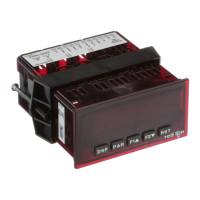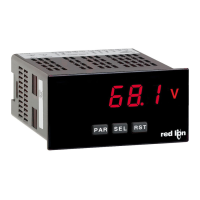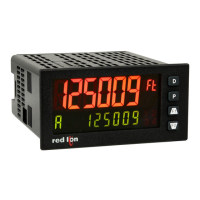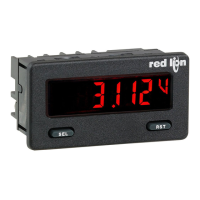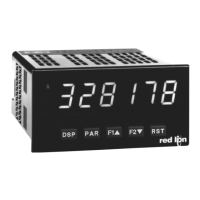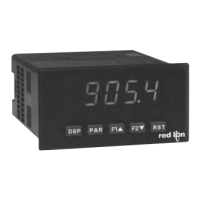PROGRAMMING MODULE #1 - SCALE BY SIGNAL LEVEL METHOD
PROGRAM DECIMAL POINT POSITION
Select the desired decimal point position of the scaled display by pressing
either the “Up” or “Down” button.
Note: Whatever decimal point is selected will appear in succeeding
programming steps. Also, the “P” button must be pressed after each step to enter
the desired data and to proceed to the next step.
“ dECPNt”<>“0”
“0.0”
“0.00”
“0.000”
“0.0000”
PROGRAM ROUNDING INCREMENT AND RIGHT HAND
DUMMY ZEROS
Rounding values other than one cause the scaled number to ‘round’ to the
nearest rounding increment selected (ie. rounding of ‘5’ causes ‘122’ to round to
‘120’ and ‘123’ to round to ‘125’). If the process is inherently jittery, the display
value may be rounded to a higher value than one. If the range of the process
exceeds the required resolution, (ex. 0-10,000 PSI, but only 10 PSI resolution
required), a rounding increment of 10 will effectively make the display more
stable. This programming step is usually used in conjunction with programmable
digital filtering (Pro 4) to help stabilize display readings. (If display stability
appears to be a problem and the sacrifice in display resolution is unacceptable,
program higher levels of digital filtering or increase the level of process
dampening.) Rounding increments of 10, 20, 50, and 100 may also be used to add
“dummy zeros” to the scaled readings, as desired.
“round”< > “1”
“2”
“5”
“10”
“20”
“50”
“100”
At this stage a choice of either return to “Pro 0” or continue with scaling of the
display is offered.
“SCALE” < > “yES”
“NO”
If “yES” was selected for the previous step, the scaling procedure is started. In
order to scale the indicator, by either method, two signal level values and two
display values that correspond to the signal values must be known. These four
values are then used to complete the scaling operation. An example of a
signal-display pair is listed below:
3.000 PSI @ 4.000 mA AND 15.000 PSI @ 20.000 mA
Scaling point #1 Scaling point #2
Note that reverse acting indication can be accomplished by either reversing the
two signal points or the display value points, but not both. If both are reversed, then
forward (normal) acting indication will occur. In either case do not reverse the input
wires to correct the action because the indicator is designed for positive signals only.
With this scaling procedure, the display values are keyed in and signal values are
applied to the indicator by either a signal simulator or the actual signal source.
KEY-IN DISPLAY VALUE FOR SCALING POINT #1
“ dSP 1” < > “-99999” to “99999” (ex. 3.000 PSI)
APPLY SIGNAL TO INDICATOR FOR SCALING POINT #1
The meter will indicate the actual amount of signal being applied to the input .
However, the indicator still retains the previously applied value until “P” is
pressed, at which time the new value is stored. Pressing either the “UP” or
“DOWN” button causes the previous value to remain programmed in the unit.
“INP 1” < > “0-50” (ex. 4.000)
KEY-IN DISPLAY VALUE FOR SCALING POINT #2
“dSP 2” < > “-99999” to “99999” (ex. 15.000 PSI)
-6-
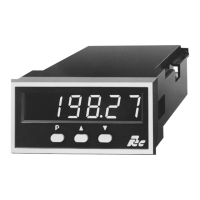
